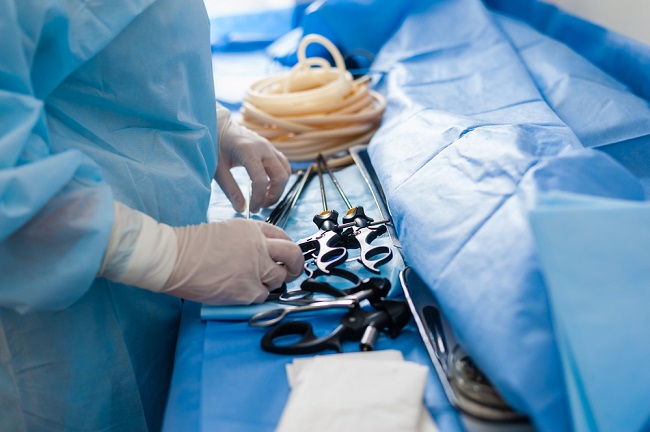Know What Is Laparoscopic Hernia Surgery
Laparoscopic hernia surgery is a fast operation with minimal pain in dealing with a hernia. In addition, laparoscopic hernia surgery requires smaller incisions than open surgery.
Hernias are conditions in which there is an organ that pushes a weak protective layer (muscle or tissue), which holds the organ stay in place. As a result, these organs will protrude out and have the potential to cause symptoms, one of which is pain in the problematic part.
In this article will be discussed about the operation for inguinal hernia, also known as umbilical term, ie conditions in where the organs in the stomach, such as the intestine, protrude through the tissue or surrounding muscles that are weakened.
Hernias can basically be treated with two types of surgery, namely open surgery (surgery) and laparoscopic surgery. Hernia surgery by laparoscopy alone includes a minimally invasive surgical procedure, or surgery that only requires a small incision in the abdominal wall. This procedure is performed with the help of a device called a laparoscope. This tool is shaped like a hose equipped with a camera and light.

Indications for Operation of Hernias d with Laparoscopy
Not all hernias need surgery. Surgery will be recommended on hernias with certain conditions, including:
- Existing symptoms are increasingly disruptive and worsening.
- Hernias get bigger.
- Body organs pinched so that its function does not run normally (hernia strangulata).
Hernias can basically be treated with two types of surgery, namely open surgery and surgery with laparoscopy or keyhole surgery. Compared to open surgery, laparoscopic hernia surgery has a faster recovery period and requires a smaller incision. Therefore, laparoscopic hernia surgery is generally more recommended for patients who have conditions such as liver disease, blood clotting disorders, and hypertension, than open surgery.
Warning Hernia surgery d With Laparoscopy
Before surgery is performed, the doctor will ask the patient to tell you the history of the disease. Some conditions that require special attention are:
- Respiratory disorders.
- Skin infections.
- Diabetes.
In addition to disease history, also inform your doctor if you are taking certain medications, especially:
- Anticoagulants, such as heparin and warfarin.
- Non-steroidal anti-inflammatory drugs, such as ibuprofen.
- Vitamin K.
- Herbal products and supplements.
Laparoscopy in children should be consulted with a doctor first, because of the handling of a hernia in children can be different.
This procedure uses anesthesia (anesthesia). For patients who have a history of allergies to anesthesia, it is better to consult with your doctor before surgery.
Hernia Surgery Preparation d With Laparoscopy
Before the operation begins, the doctor will perform an examination, such as checking blood pressure and heart rate. Doctors can also do imaging tests, such as MRI or CT scans. This examination will help the doctor prepare for surgery, and anticipate complications.
Patients will also be asked to fast 6-12 hours before surgery. In addition, patients must also avoid smoking. Smoking can inhibit postoperative recovery, as well as cause complications. The hair around the operating area will also be trimmed before surgery.
Hernia d with Laparoscopic
Before the surgical procedure begins, the patient will be injected with an anesthetic through the blood vessels in the arm and fitted with a breathing apparatus. When the anesthesia effect works, the surgical procedure begins. The patient will not feel anything during surgery.
Laparoscopic hernia surgery begins with making a small incision in the abdominal wall. The incision is generally divided into 3, measuring about 1-1.5 cm, and is used to enter the laparoscope along with other surgical support devices.
Then, one of the special tools is used to enter carbon dioxide gas into the stomach . The gas serves to create space in the stomach, separating the abdominal wall from the organs, so that the surgeon can see the condition of the organ more clearly. . Doctors assisted by other medical officers will return the troubled organs to their original location. When the problematic organ has been repaired, the gap in the muscle tissue that becomes the organ's exit site closes with a mesh or special net.
After the mesh or special net is installed well, the procedure continues to the final stage. Laparoscopes along with other surgical support devices will be issued. The incision will also be sewn and bandaged. Operating time ranges from 30-45 minutes.
After Surgery Hernia d with Laparoscopy
When the surgery is complete, the patient can take a short break in the ward until the drug effect disappears completely. The patient must be accompanied by family or relatives when they want to return home after the surgery is complete. The effect of anesthesia makes patients not recommended to drive until the next 24 hours.
Scars can cause pain for the next few days. Doctors can prescribe medications to relieve symptoms of pain.
Pain in the shoulder and flatulence after the procedure can also appear and be classified as reasonable. This is the effect of carbon dioxide used during the procedure.
The recovery period generally lasts for 1 week. If within 1 week there are still many complaints that are felt due to the procedure, immediately see a doctor. Here are some things that can help recovery:
- Get enough rest.
- Avoid heavy activities.
- Avoid wearing tight clothes.
- Avoid using tight clothes.
Other reactions such as continuous vomiting or increased body temperature can occur. It would be better if the patient is supervised at least 24 hours after the procedure.
Laparoscopic Hernia Surgery Complications
Laparoscopic hernia surgery is a safe procedure. However, immediately notify your doctor if after a surgery having a complaint in the form of:
- Fever.
- Continuous abdominal pain.
- Former incisions swell, redden, or bleeding occurs.
- Tightness
- Cannot urinate.
Because this procedure also uses anesthesia, there are some side effects from drugs that can occur, such as:
- Nausea.
- Vomiting.
- Dry mouth.
- Sore throat.
- Shaking.
- Hoarseness.
- Drowsiness.